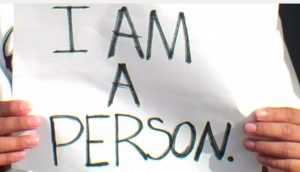Greetings and welcome from the Disabilities and Underrepresented Populations TIG week. We are June Gothberg, Chair and Caitlyn Bukaty, Program Chair. This week we have a strong line up of great resources, tips, and lessons learned for engaging typically underrepresented population in evaluation efforts.
You might have noticed that we changed our name from Disabilities and Other Vulnerable Populations to Disabilities and Underrepresented Populations and may be wondering why. It came to our attention during 2016 that sever of our members felt our previous name was inappropriate and had the potential to be offensive. Historically, a little under 50% of our TIGs presentations represent people with disabilities, the rest are a diverse group ranging from migrants to teen parents. The following Wordle shows the categorical information of presentations our TIGs presentation
Categories represented by the Disabilities and Underrepresented Populations presentations from 1989-2016
TIG members felt that the use of vulnerable in our name set up a negative and in some cases offensive label to the populations we represent. Thus, after discussion, communications, and coming to consensus we proposed to the AEA board that our name be changed to Disabilities and Underrepresented Populations.
Lessons Learned:
- Words are important! Labels are even more important!
- Words can hurt or empower, it’s up to you.
- Language affects attitudes and attitudes affect actions.
Hot Tips:
- If we are to be effective evaluators we need to pay attention to the words we use in written and verbal communication.
- Always put people first, labels last. For example, student with a disability, man with autism, woman with dyslexia.
The nearly yearlong name change process reminded of the lengthy campaign to rid federal policy and documents of the R-word. If you happened to miss the Spread the Word to End the Word Campaign, there are several great video and other resources at r-word.org.

https://www.youtube.com/watch?v=kTGo_dp_S-k&feature=youtu.be
Bill S. 2781 put into federal law, Rosa’s Law, which takes its name and inspiration for 9-year-old Rosa Marcellino, removes the terms “mental retardation” and “mentally retarded” from federal health, education and labor policy and replaces them with people first language “individual with an intellectual disability” and “intellectual disability.” The signing of Rosa’s Law is a significant milestone in establishing dignity, inclusion and respect for all people with intellectual disabilities.
So, what’s in a name? Maybe more than you think!


Hello June and Caitlyn,
Thank you for this important reminder. While most of us strive to minimize harm to ourselves and others in our practice, there are times of unintentional harm as you outlined in your post. As a primary school teacher, I am expected to speak to and about students in such a way that labels the behaviour, not the child. I might say, “Johnny experiences dizziness” (as an innocuous example) rather than “That dizzy boy” or “That was a bad choice” rather than “You were a bad boy”. It speaks to the universal need to be acknowledged as a whole person and links back to your hot tip about choosing words that empower rather than hurt.
I am currently enrolled in a master’s course in evaluation and discovered AEA 365 as one of the listed resources. I can see that evaluators, like educators, must always keep the ethics of interaction in mind and hold one another accountable for our language and the impact it has on stakeholders. This is most important to minimize harm but also because we need to strive to be amiable and open to gain stakeholder trust and cooperation. Have you encountered anyone who was opposed to your name change? I participated in a Light It Up Blue campaign for people with autism a few years ago and was surprised to receive a message from a colleague who took offense. As a parent of a child on the spectrum, he felt putting the person before the label (A child with autism) was inaccurate, minimizing his child’s experience and an important aspect of their identity, preferring instead the term autistic child. When you are engaged in an evaluation and encounter these stumbling blocks to trust with stakeholders, how can you remedy the situation, beyond expressing goodwill?
Andrea